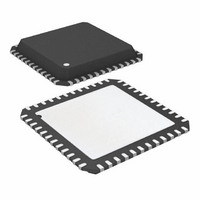AD7667ACP Analog Devices Inc, AD7667ACP Datasheet - Page 22

AD7667ACP
Manufacturer Part Number
AD7667ACP
Description
IC ADC 16BIT UNIPOLAR 48-LFCSP
Manufacturer
Analog Devices Inc
Series
PulSAR®r
Datasheet
1.AD7667ASTZ.pdf
(28 pages)
Specifications of AD7667ACP
Rohs Status
RoHS non-compliant
Number Of Bits
16
Sampling Rate (per Second)
1M
Data Interface
Serial, Parallel
Number Of Converters
1
Power Dissipation (max)
145mW
Voltage Supply Source
Analog and Digital
Operating Temperature
-40°C ~ 85°C
Mounting Type
Surface Mount
Package / Case
48-VFQFN, CSP Exposed Pad
For Use With
EVAL-AD7667CBZ - BOARD EVALUATION FOR AD7667
AD7667
DIGITAL INTERFACE
The AD7667 has a versatile digital interface; it can be interfaced
with the host system by using either a serial or a parallel
interface. The serial interface is multiplexed on the parallel data
bus. The AD7667 digital interface also accommodates both 3 V
and 5 V logic by simply connecting the OVDD supply pin of the
AD7667 to the host system interface digital supply. Finally, by
using the OB/ 2C input pin, both twos complement or straight
binary coding can be used.
The two signals, CS and RD , control the interface. CS and RD
have a similar effect because they are OR’d together internally.
When at least one of these signals is HIGH, the interface
outputs are in high impedance. Usually CS allows the selection
of each AD7667 in multicircuit applications and is held low in a
single AD7667 design. RD is generally used to enable the
conversion result on the data bus.
PARALLEL INTERFACE
The AD7667 is configured to use the parallel interface when
SER/ PAR is held LOW. The data can be read either after each
conversion, which is during the next acquisition phase, or
during the following conversion, as shown in Figure 36 and
Figure 37, respectively. When the data is read during the
conversion, however, it is recommended that it is read only
during the first half of the conversion phase. This avoids any
potential feedthrough between voltage transients on the digital
interface and the most critical analog conversion circuitry.
The BYTESWAP pin allows a glueless interface to an 8-bit bus.
As shown in Figure 38, the LSB byte is output on D[7:0] and the
MSB is output on D[15:8] when BYTESWAP is LOW. When
BYTESWAP is HIGH, the LSB and MSB bytes are swapped and
the LSB is output on D[15:8] and the MSB is output on D[7:0].
By connecting BYTESWAP to an address line, the 16-bit data
can be read in two bytes on either D[15:8] or D[7:0].
SERIAL INTERFACE
The AD7667 is configured to use the serial interface when
SER/ PAR is held HIGH. The AD7667 outputs 16 bits of data,
MSB first, on the SDOUT pin. This data is synchronized with
the 16 clock pulses provided on the SCLK pin. The output data
is valid on both the rising and falling edges of the data clock.
Rev. 0 | Page 22 of 28
BUSY
PINS D[15:8]
CNVST,
DATA
BYTESWAP
BUS
PINS D[7:0]
CS = 0
BUSY
DATA
RD
Figure 37. Slave Parallel Data Timing for Reading (Read during Convert)
CS
BUS
Figure 36. Slave Parallel Data Timing for Reading (Read after Convert)
RD
RD
CS
HI-Z
HI-Z
t
t
12
12
t
3
Figure 38. 8-Bit Parallel Interface
CONVERSION
CONVERSION
t
CURRENT
PREVIOUS
12
t
HIGH BYTE
LOW BYTE
1
t
13
t
13
t
4
t
12
HIGH BYTE
LOW BYTE
HI-Z
HI-Z
t
13










